2019 MERCEDES-BENZ SPRINTER flat tire
[x] Cancel search: flat tirePage 27 of 354

Menus and submenus .............................
16 6Mercedes PRO
....................................... 171
Information about Mercedes PRO ............ 171
Information about Mercedes PRO con‐
nect .........................................................1 71
Calling the Mercedes-Benz Cus tomer
Center using the multimedia sy stem ........ 171
Making a call via theove rhead control
panel ........................................................ 171
Information on theRo adside Assis‐
ta nce call via theove rhead control
panel ........................................................ 171
Information on Mercedes PRO connect
accident management .............................1 72
Tr ansmit ted data during a breakdown
assis tance call ......................................... 172MBUX multimedia sy
stem .................... 17 3
Overview and operation ........................... 173
Sy stem settings ....................................... 17 9
Ve hicle information ..................................1 81
Te lephone ................................................ 182
Media ...................................................... 189
Ra dio .......................................................1 92
Sound ...................................................... 194Tr
anspo rting .......................................... 19 5
No tes on loading guidelines ..................... 19 5
Load distribution ..................................... 19 6
Secu ring loads ......................................... 19 6
Car rier sy stems ....................................... 19 8
Using the interior roof car rier sy stem ...... 19 9
Placing a load on the wheel ar ch............. 201 Main
tenance and care .......................... 202
ASS YST PLUS service inter val display .... .202
Engine compartment ............................... 202
Cleaning and care ................................... .210 Breakdown assistance
..........................216
Emergency ............................................... 216
Emergency Call Sy stem ........................... 216
Flat tire ................................................... .218
Battery ..................................................... 218
To wing or tow- starting ............................ .224
Electrical fuses ........................................ 228
Ve hicle tool kit ......................................... 229
Hydraulic jack ......................................... 230 Wheels and tires
................................... 232
Information on noise or unusual driving
ch aracteristics ........................................ .232
No tes on regular lyinspecting wheels
and tires .................................................. 232
Information on driving with summer
tires ........................................................ .232
Information on M+S tires ......................... 233
No tes on snow chains ............................ .233
Ti re pressure ...........................................2 34
Loading theve hicle ..................................2 40
Ti re labeling ............................................ .243
Information on definitions (tires and
loading) ................................................... 24 6
Changing a wheel .................................... 24 8
Spa rewheel ............................................ 255 Te
ch nical data ....................................... 260
Information on tech nical da ta.................. 260
On-board electronics ............................... 260
Ve hicle identification plate, vehicle
identification number (VIN) and engine
number ....................................................2 61
Operating fluids and capacities .............. .263
Ve hicle data ............................................. 271
Tr ailer hit ch.............................................. 271
Lashing points and car rier sy stems ......... 275 Display messages and
warning and
indicator lamps ..................................... 277
Displ aymessa ges .................................... 277
Indicator and warning lamps .................. .296 Index
...................................................... 306 Contents
3
Page 40 of 354
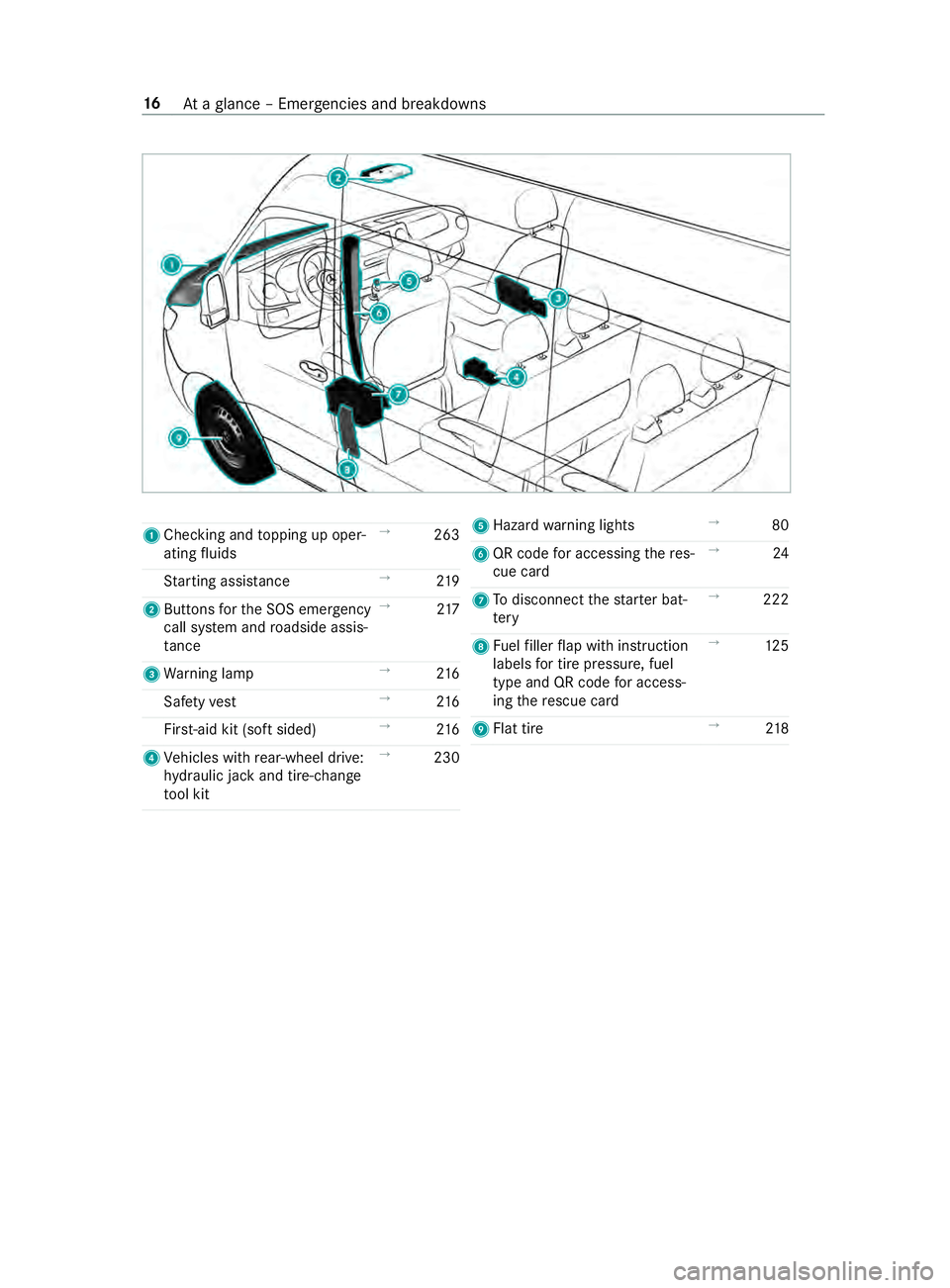
1
Checking and topping up oper‐
ating fluids →
263
St arting assis tance →
219
2 Buttons forth e SOS emer gency
call sy stem and roadside assis‐
ta nce →
217
3 Warning lamp →
216
Saf etyve st →
216
Fir st-aid kit (so ftsided) →
216
4 Vehicles with rear-wheel drive:
hy draulic jack and tire-change
to ol kit →
230 5
Hazard warning lights →
80
6 QR code for accessing there s‐
cue card →
24
7 Todisconnect thest ar ter bat‐
te ry →
222
8 Fuelfiller flap with instruction
labels for tire pressu re, fuel
type and QR code for access‐
ing there scue card →
12 5
9 Flat tire →
218 16
Ataglance – Emer gencies and breakdowns
Page 235 of 354
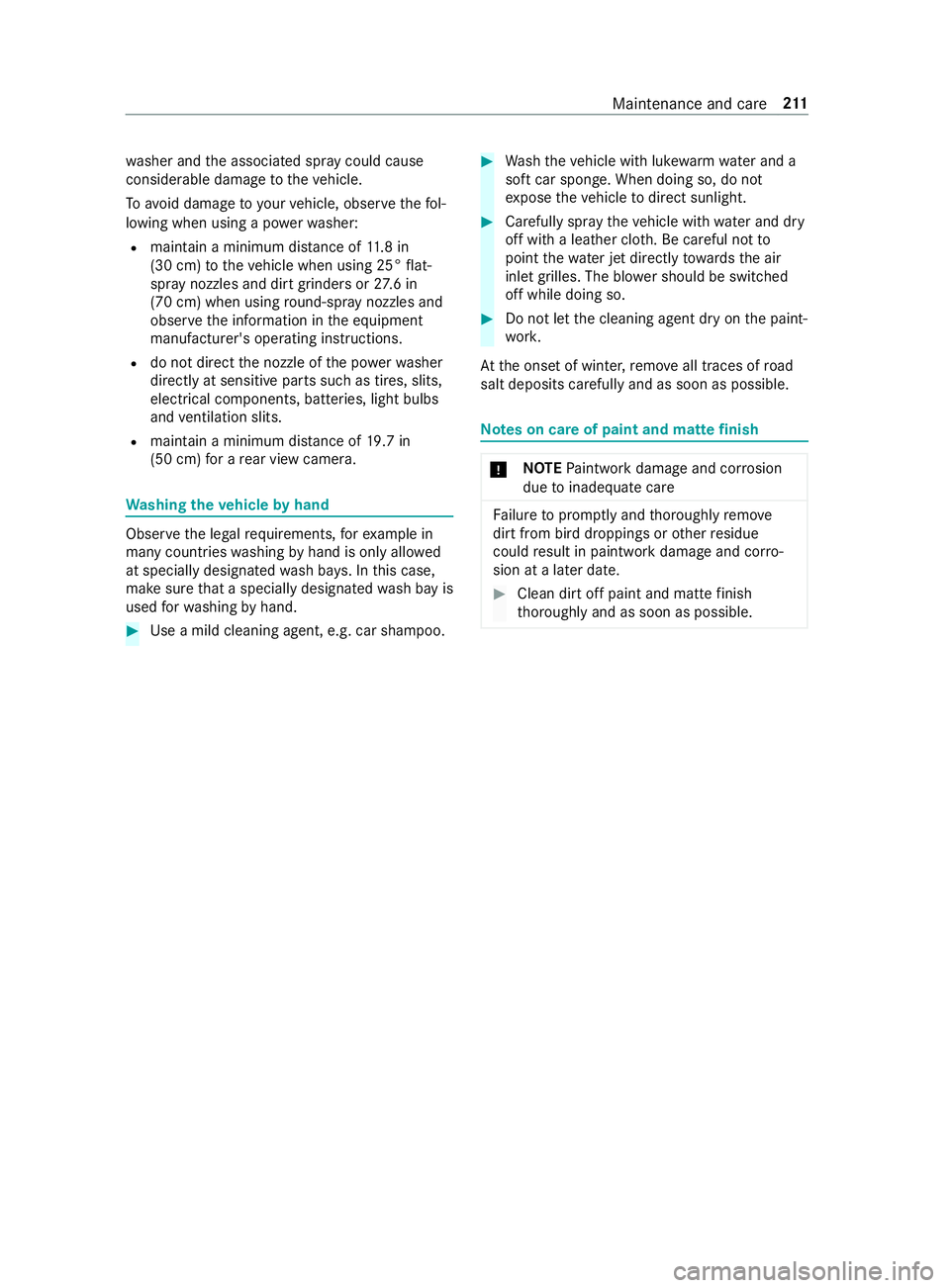
wa
sher and the associated spr aycould cause
considerable damage totheve hicle.
To avo id damage to yourvehicle, obser vethefo l‐
lowing when using a po werwa sher:
R maintain a minimum dis tance of 11.8 in
(30 cm) totheve hicle when using 25° flat-
spr aynozzles and di rtgrinders or 27.6 in
(70 cm) when using round-spray nozzles and
obse rveth e information in the equipment
manufacturer's operating instructions.
R do not direct the nozzle of the po werwa sher
directly at sensitive parts such as tires, slits,
electrical components, batteries, light bulbs
and ventilation slits.
R maintain a minimum di stance of 19.7 in
(50 cm) for a rear view camera. Wa
shing theve hicle byhand Obser
vethe legal requirements, forex ample in
many countries washing byhand is only allo wed
at specially designated wash ba ys. In this case,
make sure that a specially designated wash bay is
used forwa shing byhand. #
Use a mild cleaning agent, e.g. car shampoo. #
Washtheve hicle with luk ewarm wate r and a
soft car sponge. When doing so, do not
ex pose theve hicle todirect sunlight. #
Carefully spr aytheve hicle with water and dry
off with a leath er cloth. Be careful not to
point thewate r jet directly towa rdsth e air
inlet grilles. The blo wer should be switched
off while doing so. #
Do not let the cleaning agent dry on the paint‐
wo rk.
At the onset of winter, remo veall traces of road
salt deposits carefully and as soon as possible. Note
s on care of paint and matte finish *
NO
TEPaint wo rkdamage and cor rosion
due toinadequate care Fa
ilure toprom ptly and thoroughly remo ve
dirt from bird droppings or other residue
could result in paintwork damage and cor ro‐
sion at a later date. #
Clean dirt off paint and matte finish
th oroughly and as soon as possible. Maintenance and care
211
Page 242 of 354
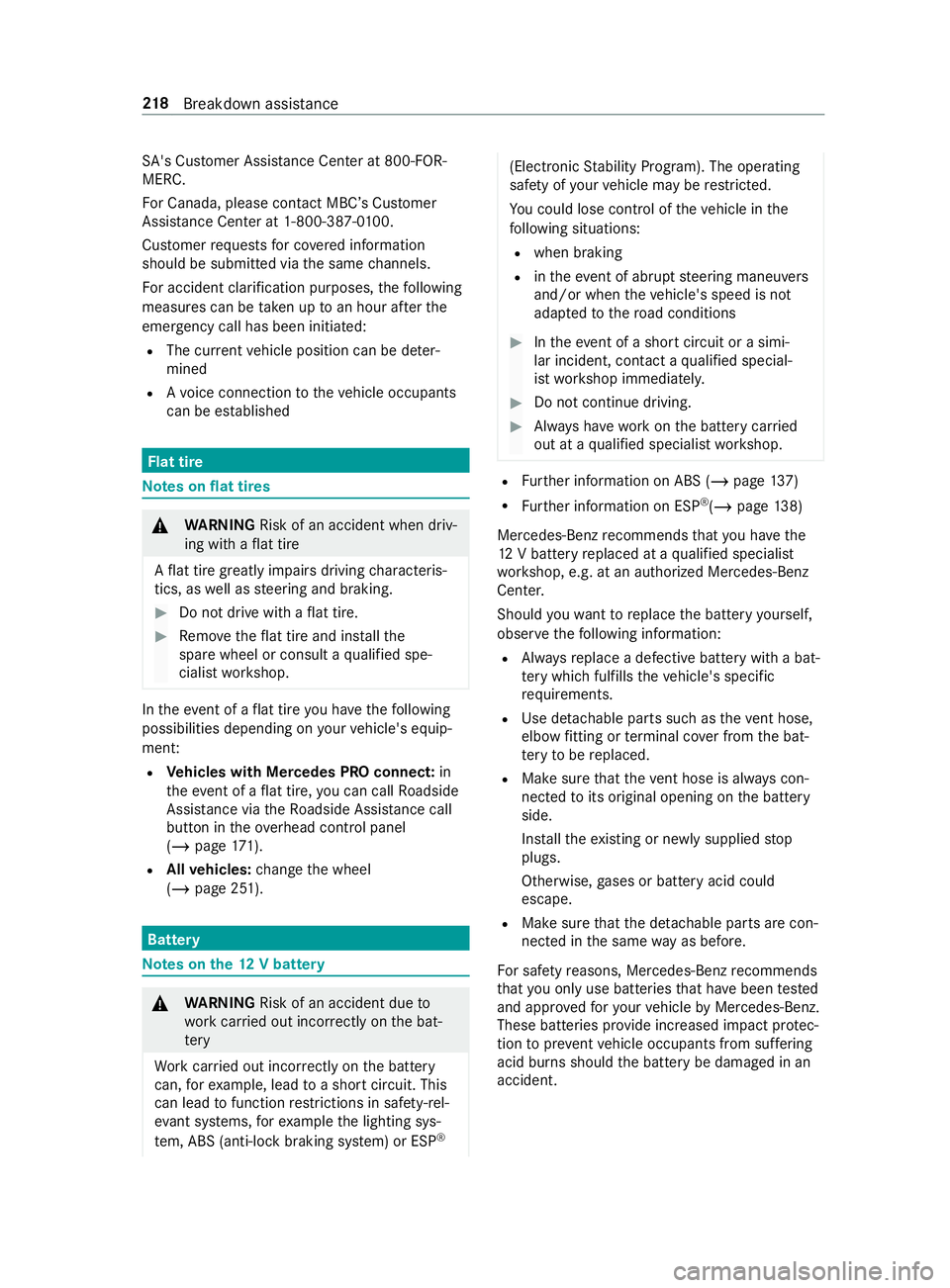
SA
's Cus tomer Assis tance Center at 800-FOR-
MERC.
Fo r Canada, please contact MBC’s Cust omer
Assis tance Center at 1-800-387-0 100.
Cust omer requ ests for co vered information
should be submitted via the same channels.
Fo r accident clarification purposes, thefo llowing
measures can be take n up toan hour af terthe
emer gency call has been initia ted:
R The cur rent vehicle position can be de ter‐
mined
R Avo ice connection totheve hicle occupants
can be es tablished Flat tire
Note
s onflat tires &
WARNING Risk of an accident when driv‐
ing wi thaflat tire
A flat tire greatly impairs driving characteris‐
tics, as well as steering and braking. #
Do not drive with a flat tire. #
Remo vetheflat tire and ins tallthe
spare wheel or consult a qualified spe‐
cialist workshop. In
theeve nt of a flat tire you ha vethefo llowing
possibilities depending on your vehicle's equip‐
ment:
R Vehicles with Mercedes PRO connec t:in
th eeve nt of a flat tire, you can call Roadside
Assis tance via theRo adside Assis tance call
button in theov erhead cont rol panel
(/ page 171).
R Allvehicles: change the wheel
(/ page 251). Batte
ry Note
s onthe12 V battery &
WARNING Risk of an accident due to
wo rkcar ried out incor rectly on the bat‐
te ry
Wo rkcar ried out incor rectly on the battery
can, forex ample, lead toa short circuit. This
can lead tofunction restrictions in saf ety-re l‐
eva nt sy stems, forex ample the lighting sys‐
te m, ABS (anti-lock braking sy stem) or ESP ® (Elect
ronic Stability Prog ram). The operating
saf ety of your vehicle may be restricted.
Yo u could lose control of theve hicle in the
fo llowing situations:
R when braking
R intheeve nt of ab rupt steering maneuvers
and/or when theve hicle's speed is not
adap tedto thero ad conditions #
Intheeve nt of a sho rtcircuit or a simi‐
lar incident, contact a qualified special‐
ist workshop immediately. #
Do not continue driving. #
Always ha vewo rkon the battery car ried
out at a qualified specialist workshop. R
Further information on ABS (/ page137)
R Further information on ESP ®
(/ page 138)
Me rcedes-Benz recommends that you ha vethe
12 V battery replaced at a qualified specialist
wo rkshop, e.g. at an authorized Mercedes-Benz
Center.
Should youwa nttoreplace the battery yourself,
obse rveth efo llowing information:
R Alwaysre place a defective battery with a bat‐
te ry which fulfills theve hicle's specific
re qu irements.
R Use de tach able parts such as theve nt hose,
elbow fitting or term inal co ver from the bat‐
te ry to be replaced.
R Make sure that theve nt hose is al ways con‐
nected toits original opening on the battery
side.
Ins tallth eex isting or newly supplied stop
plugs.
Otherwise, gases or battery acid could
escape.
R Make sure that the de tach able parts are con‐
nec ted in the same way as before.
Fo r saf etyre asons, Mercedes-Benz recommends
th at you only use bat teries that ha vebeen tested
and appr ovedfo ryo ur vehicle byMercedes-Benz.
These batteries pr ovide inc reased impact pr otec‐
tion topreve ntvehicle occupants from suf fering
acid bu rns should the battery be damaged in an
accident. 218
Breakdown assis tance
Page 260 of 354
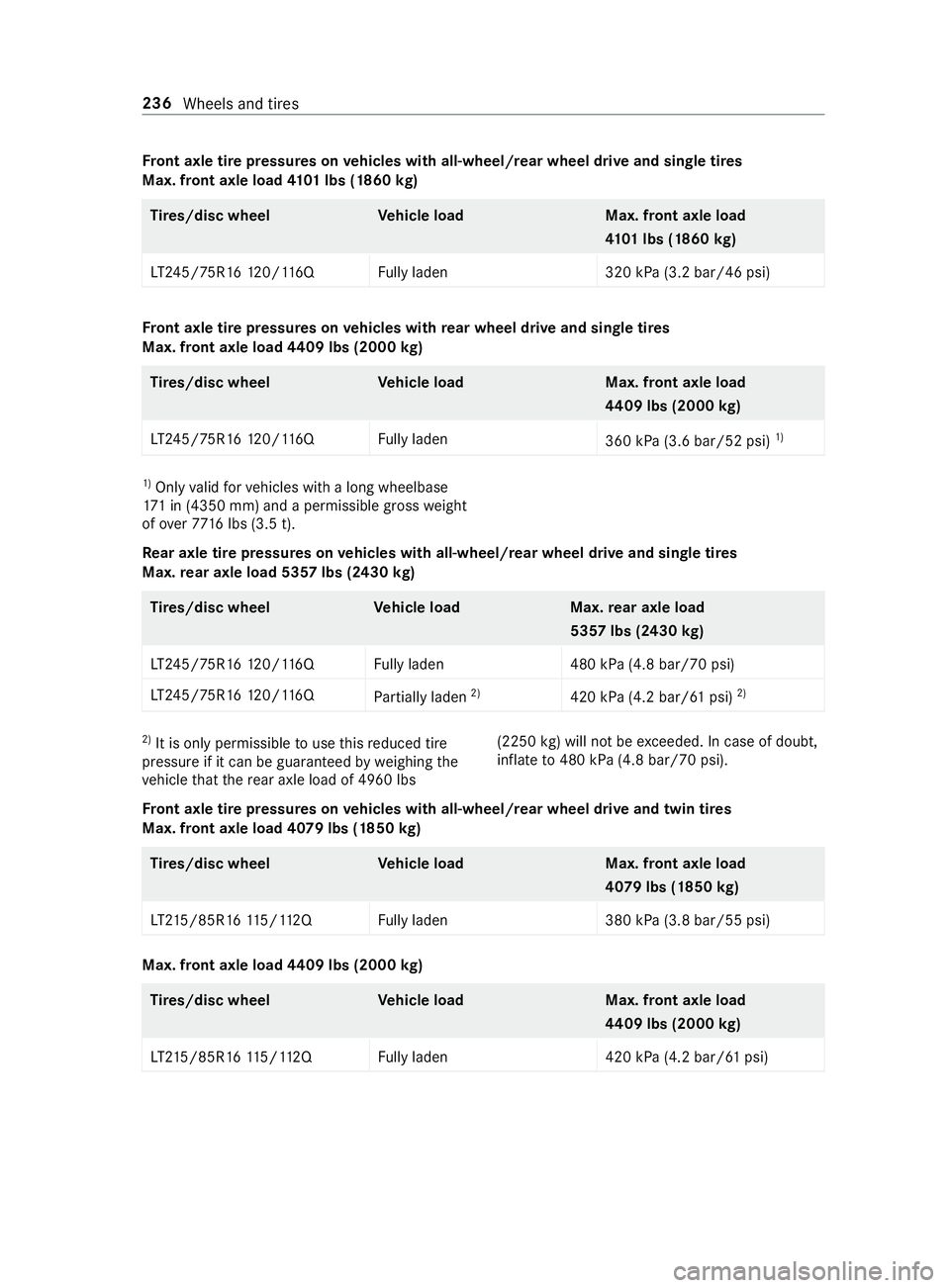
Fr
ont axle tire pressures on vehicles with all-wheel/rear wheel drive and single tires
Max. front axle load 4101 lbs (1860 kg) Ti
re s/disc wheel Vehicle load Max. front axle load
41 01 lbs (1860 kg)
LT 24 5/75R16 120/1 16QF ully laden 320 kPa (3.2 bar/46 psi)Fr
ont axle tire pressures on vehicles with rear wheel drive and single tires
Max. front axle load 4409 lbs (2000 kg) Ti
re s/disc wheel Vehicle load Max. front axle load
44 09 lbs (2000 kg)
LT 24 5/75R16 120/1 16QF ully laden
360 kPa (3.6 bar/52 psi)1)1)
Only valid forve hicles with a long wheelbase
17 1 in (4350 mm) and a permissible gross weight
of ove r77 16 lbs (3.5 t).
Re ar axle tire pressures on vehicles with all-wheel/rear wheel drive and single tires
Max. rear axle load 5357 lbs (2430 kg)Ti
re s/disc wheel Vehicle load Max.rear axle load
5357 lbs (2430 kg)
LT 24 5/75R16 120/1 16QF ully laden 480 kPa (4.8 bar/70 psi)
LT 24 5/75R16 120/1 16 Q
Partially laden 2)
420 kPa (4.2 bar/61 psi) 2)2)
It is only permissible touse this reduced tire
pressure if it can be guaranteed byweighing the
ve hicle that there ar axle load of 4960 lbs (2250
kg) will not be exceeded. In case of doubt,
inflate to480 kPa (4.8 bar/70 psi).
Fr ont axle tire pressures on vehicles with all-wheel/rear wheel drive and twin tires
Max. front axle load 4079 lbs (1850 kg)Ti
re s/disc wheel Vehicle load Max. front axle load
4079 lbs (1850 kg)
LT 21 5/85R16 115/1 12QF ully laden 380 kPa (3.8 bar/55 psi)Max. front axle load
4409 lbs (2000 kg) Ti
re s/disc wheel Vehicle load Max. front axle load
44 09 lbs (2000 kg)
LT 21 5/85R16 115/1 12QF ully laden 420 kPa (4.2 bar/61psi) 236
Wheels and tires
Page 262 of 354

Re
ar axle tire pressures on vehicles with rear wheel drive and Super Single tires
Max. rear axle load 7055 lbs (3200 kg)Ti
re s/disc wheel Vehicle load Max.rear axle load
7055 lbs (3200 kg)
225/75R16C 121/120R (122L) Fully laden
690 kPa (6.9 bar/100 psi)3)
285/65R16C 131R Fully laden 460 kPa (4.6 bar/67 psi)Max.
rear axle load 7716 lbs (3500 kg) Ti
re s/disc wheel Vehicle load Max.rear axle load
77 16 lbs (3500 kg)
225/75R16C 121/120R (122L) Fully laden
690 kPa (6.9 bar/100 psi)3)
285/65R16C 131R Fully laden 520 kPa (5.2 bar/75 psi)3)
Va lid touse for a short time as a spare wheel
on there ar axle for a maximum dis tance of
62 miles (100 km) and a maximum speed of
34 mph (55 km/h).
Be sure toalso obse rveth efo llowing fur ther rela‐
te d subjects:
R Notes on tire pressure (/ page 234)
R Tire and Loading In form ation placard
(/ page 240)
R Maximum tire pressure (/ page 245) Ti
re pressure moni tor Fu
nction of tire pressure monitor on single
tires &
DANG ER Risk of accident due toincor‐
re ct tire pressure
Every tire, including the spare (if pr ovided),
should be checked when cold at least once a
month and inflated tothe pressure recom‐
mended bytheve hicle manufacturer (see Tire
and Loading In form ation placard on the B-pil‐
lar on the driver ’sside or the tire pressure
label on the inside of the fuel filler flap of your
ve hicle). If your vehicle has tires of a dif fere nt
size than the size indicated on theTire and
Loading In form ation placard or the tire pres‐
sure table, you need todeterm ine the proper
tire pressure forth ose tires.
As an added saf etyfe ature, your vehicle has
been equipped with a tire pressure monitor‐ ing sy
stem (TPMS) that illuminates a low tire
pressure indicator lamp when one or more of
yo ur tires are significantly unde rinfla ted.
Ac cording ly, if the low tire pressure indicator
lamp lights up, you should stop and check
yo ur tires as soon as possible, and inflate
th em tothe proper pressure. Driving on a sig‐
nificant lyunde rinfla ted tire causes the tire to
ove rheat and can lead totire failure. Underin‐
fl ation also inc reases fuel consum ption and
re duces tire tread life, and may af fect the
ve hicle's handling and braking ability. Please
no te that the TPMS is not a substitute for
proper tire maintenance, and it is the driver's
re sponsibility tomaintain cor rect tire pres‐
sure, even if underinflation has not reached
th e le velto trig ger illumination of the TPMS
low tire pressure indicator lamp.
Yo ur vehicle has also been equipped with a
TPMS malfunction indicator toindicate when
th e sy stem is not operating properly. The
TPMS malfunction indicator is combined with
th e low tire pressure indicator lamp. When
th e sy stem de tects a malfunction, the indica‐
to r lamp will flash for appro ximately a minute
and then remain continuously illumina ted.
This sequence will continue upon subsequent
ve hicle start-ups as long as the malfunction
ex ists.
When the malfunction indicator is illuminated,
th e sy stem may not be able todetect or sig‐
nal low tire pressu reas intended. TPMS mal‐
functions may occur for a variet y of reasons,
including the ins tallation of incompatible 238
Wheels and tires
Page 268 of 354
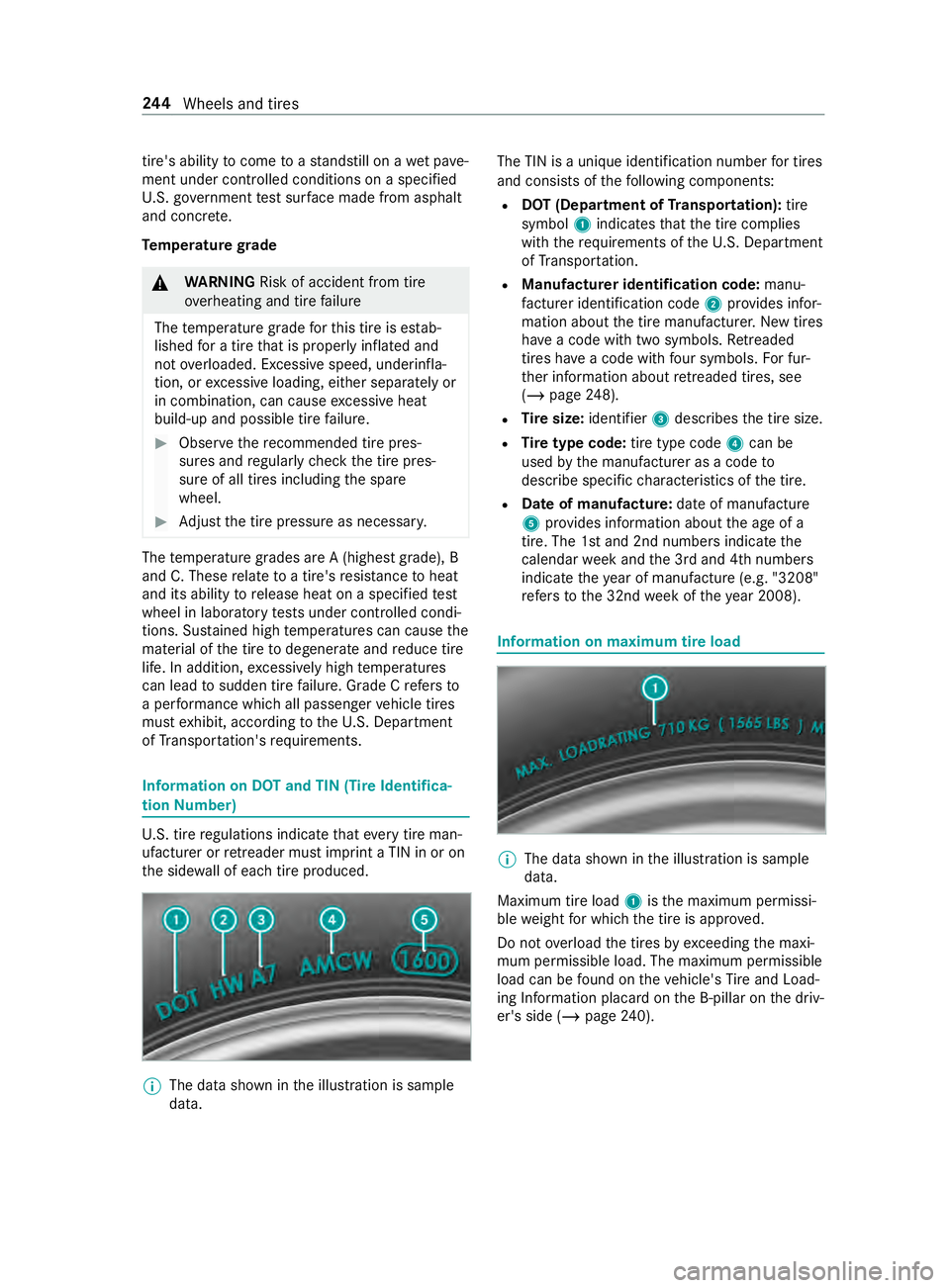
tire's ability
tocome toast andstill on a wet pa ve‐
ment under controlled conditions on a specified
U. S. go vernment test sur face made from asphalt
and concr ete.
Te mp erature grade &
WARNING Risk of accident from tire
ove rheating and tire failure
The temp erature grade forth is tire is es tab‐
lished for a tire that is properly inflated and
not overloaded. Excessive speed, underinfla‐
tion, or excessive loading, either separately or
in combination, can cause excessive heat
build-up and possible tire failure. #
Obser vethere commended tire pres‐
sures and regular lych eck the tire pres‐
sure of all tires including the spare
wheel. #
Adjust the tire pressure as necessar y.The
temp erature grades are A (highest grade), B
and C. These relate toa tire's resis tance toheat
and its ability torelease heat on a specified test
wheel in laboratory tests under contro lled condi‐
tions. Sus tained high temp eratures can cause the
material of the tire todegenerate and reduce tire
life. In addition, excessively high temp eratures
can lead tosudden tire failure. Grade C refers to
a per form ance which all passenger vehicle tires
must exhibit, according totheU. S. Depa rtment
of Transpor tation's requ irements. Information on DOT and TIN (Tire Identifica‐
tion Number) U.
S. tire regulations indicate that every tire man‐
ufacturer or retreader mu stimprint a TIN in or on
th e side wall of each tire produced. %
The data shown in
the illustration is sample
data. The TIN is a unique identification number
for tires
and consists of thefo llowing components:
R DOT (Department of Transportation): tire
symbol 1indicates that the tire complies
with therequ irements of theU. S. Depa rtment
of Transpor tation.
R Manufacturer identi fication code: manu‐
fa cturer identification code 2prov ides infor‐
mation about the tire manufacturer. New tires
ha ve a code with two symbols. Retreaded
tires ha vea code with four symbols. For fur‐
th er information about retreaded tires, see
(/ page 248).
R Tire size: identifier 3describes the tire size.
R Tire type code: tire type code 4can be
used bythe manufacturer as a code to
describe specific characteristics of the tire.
R Date of manu factu re:da te of manufacture
5 prov ides information about the age of a
tire. The 1st and 2nd numbers indicate the
calendar week and the 3rd and 4th numbers
indicate theye ar of manufacture (e.g. "3208"
re fers to the 32nd week of theye ar 2008). Information on maximum tire load
%
The data shown in
the illustration is sample
data.
Maximum tire load 1isthe maximum permissi‐
ble weight for which the tire is appr oved.
Do not overload the tires by exceeding the maxi‐
mum permissible load. The maximum permissible
load can be found on theve hicle's Tire and Load‐
ing In form ation placard on the B-pillar on the driv‐
er's side (/ page240). 244
Wheels and tires
Page 273 of 354

Before pu
rchasing and using non-appr oved
accesso ries, visit a qualified specialist workshop
and inquire about:
R Suitability
R Legal stipulations
R Factory recommendations
Obser vethefo llowing points when selecting,
ins talling and replacing tires:
R Use only tires and wheels of the same type,
design (winter tires, all-season tire) and
make.
R Only ins tall wheels of the same size and tread
design on one axle (left and right).
It is only permissible toins tall a dif fere nt
wheel size tothis in theeve nt of a flat tire in
order todrive tothe specialist workshop.
R Only ins tall tires of the cor rect size onto the
wheels.
R Ve
hicles with a tire pressure monitoring
sy stem: all ins talled wheels must be equip‐
ped with functioning sensors forth e tire pres‐
sure monitoring sy stem.
R Attemp eratures below 50 °F (10 °C), use
winter tires or all-season tire mar ked M+S for
all wheels.
Wi nter tires bearing the004D snowflake sym‐
bol in addition tothe M+S marking pr ovide
th e best possible grip in wintry road condi‐
tions.
R Only use tires with the same tread.
R Obser vethe maximum permissible speed for
th e ins talled tires.
If th is is below theve hicle's maximum speed,
th is must be indicated in an appropriate label
in the driver's field of vision.
R Break in new tires at moderate speeds forthe
fi rs t 60 miles (100 km).
R Replace the tires af ter six years at the latest,
re ga rdless of wear.
Fo r more information on wheels and tires, con‐
ta ct a qualified specialist workshop.
% Ve
hicles with twin tires:
Fo rve hicles with twin tires with a GVW of
11 ,030 lbs or 12,125 lbs, only use tires with
th e dimension LT215/85 R16 whi chhave
been appr ovedfo rth is vehicle bythe manu‐
fa cturer. It is not permissible touse tires with
dif fere nt dimensions; doing so may lead to age
neral ope rating pe rmit being rende red
in va lid.
% Ve
hicles with single tires:
Fo rve hicles with single tires with a GVW less
th an or equal to9480 lbs, only use tires with
th e dimension LT245/75 R16 whi chhave
been appr ovedfo rth is vehicle bythe manu‐
fa cturer. It is not permissible touse tires with
dif fere nt dimensions; doing so may lead to a
ge neral ope rating pe rmit being rende red
in va lid.
% Ve
hicles with Super Single tires:
Fo rve hicles with single tires with a GVW of
11 ,030 lbs, only use tires with the dimen‐
sions 225/ 75R16C (FA) and 285/65 R16C
(RA) which ha vebeen appr ovedfo rth is vehi‐
cle bythe manufacturer. It is not permissible
to use tires with dif fere nt dimensions; doing
so may lead toage neral ope rating pe rmit
being rende red in valid.
Be sure toalso obse rveth efo llowing fur ther rela‐
te d subjects:
R Notes on tire pressure (/ page 234)
R Tire and Loading In form ation placard
(/ page 240)
R Tire size designation, load-beari ng capacity,
speed rating and load ind ex (/page 245)
R Tire pressure table
R Notes on the emer gency spa rewheel
(/ page 255) Note
s onrotating wheels &
WARNING Risk of inju rythro ugh dif fer‐
ent wheel sizes
Inter changing the front and rear wheels if the
wheels or tires ha vediffere nt dimensions may
se verely impair the driving characteristics.
The wheel brakes or wheel suspension com‐
ponents may also be damaged. #
Rotate front and rear wheels only if the
wheels and tires are of the same dimen‐
sions. On
vehicles that ha vethe same size front and
re ar wheels, rotate the wheels according tothe
inter vals in the tire manufacturer's warranty book
in your vehicle documents. If this is not available,
ro tate the tires every3,000 (5,000) to
6,000 miles (10,000 km), depending on the Wheels and tires
249